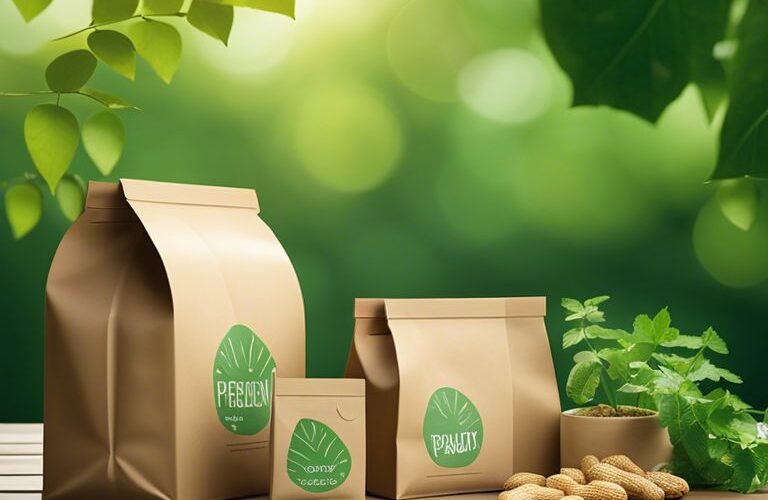Delve into the world of eco-friendly packaging materials as we uncover the sustainable options available for businesses and individuals alike. In this informative blog post, we will discuss the importance of reducing environmental impact and the dangers of non-sustainable packaging materials. We will also highlight the benefits of using eco-friendly packaging materials and explore various sustainable options that are both effective and environmentally responsible.
Table of Contents
Understanding Eco-Friendly Materials
A key aspect of sustainable packaging is the use of eco-friendly materials. By choosing the right materials, businesses can minimize their environmental impact and contribute to a healthier planet. With a growing emphasis on sustainability, it is crucial to understand the different types of eco-friendly materials available and their impact on the environment.
Biodegradable vs. Compostable Materials
The terms “biodegradable” and “compostable” are often used interchangeably, but they represent different processes. Biodegradable materials break down naturally over time, but they may leave behind toxic residue or by-products. On the other hand, compostable materials not only break down into natural elements but also enrich the soil, making them a more sustainable choice. By opting for compostable materials, businesses can contribute to the creation of nutrient-rich soil, reduce waste in landfills, and promote a circular economy.
Recyclable Materials and Their Impact
To minimize the environmental impact of packaging, it is essential to consider the recyclability of materials. Recyclable materials, such as paper, cardboard, glass, and certain types of plastic, can be processed and re-manufactured into new products. This reduces the need for raw materials, conserves energy, and decreases the amount of waste sent to landfills. By choosing recyclable materials, businesses can support a more sustainable and circular approach to packaging, contributing to the preservation of natural resources and the reduction of pollution.
Any business that aims to prioritize sustainability should consider the use of recyclable materials in their packaging solutions. This not only aligns with consumer preferences for environmentally friendly products but also helps in reducing the carbon footprint of the business operations.
Innovations in Sustainable Packaging
While the need for sustainable packaging materials is becoming more evident, the good news is that there have been significant innovations in the industry. As consumer demand for sustainable packaging grows, companies are investing in developing eco-friendly alternatives to traditional packaging materials.
Plant-Based Packaging Solutions
Packaging made from plant-based materials is gaining traction as a sustainable alternative to traditional plastics. These materials, derived from renewable resources such as corn, sugarcane, and algae, offer biodegradable and compostable properties, making them an attractive option for environmentally conscious consumers and businesses. Furthermore, plant-based packaging solutions significantly reduce the reliance on fossil fuels and help in lowering carbon emissions, contributing to a healthier planet.
Edible Packaging Trends
One of the most innovative trends in sustainable packaging is the development of edible packaging. Edible packaging is made from biodegradable materials such as seaweed, rice, or potatoes, and is designed to be consumed along with the food or beverage it contains. This eliminates the need for single-use packaging and reduces food waste, offering a zero-waste solution to the environmental concerns associated with traditional packaging materials.
With the potential to revolutionize the way we package and consume products, edible packaging is a promising solution for combating plastic pollution and promoting sustainable consumer habits. As more research and development are dedicated to this innovative concept, edible packaging is expected to play a significant role in the future of sustainable packaging materials.
Challenges and Solutions
Now, let’s delve into the challenges that businesses face when it comes to adopting eco-friendly packaging materials and the solutions available to address them.
Addressing Cost and Scalability
On the one hand, businesses may be concerned about the cost implications of transitioning to sustainable packaging materials. The initial investment in eco-friendly alternatives may seem daunting, especially for smaller companies with limited resources. However, over the long run, the use of sustainable packaging can lead to cost savings through reduced material usage and waste management expenses. Additionally, as demand for eco-friendly products continues to rise, the scalability of sustainable packaging solutions is also improving. Suppliers and manufacturers are continuously innovating to offer a wider range of options at competitive prices, making it more feasible for businesses of all sizes to make the switch.
Furthermore, collaboration across the supply chain is crucial in addressing cost and scalability challenges. By working closely with suppliers, manufacturers, and other stakeholders, businesses can find ways to optimize processes and reduce costs associated with sustainable packaging materials. Additionally, investing in research and development can lead to the discovery of more cost-effective and scalable solutions, contributing to the overall growth of eco-friendly packaging options in the market.
Compliance with Global Standards
Compliance with global standards for eco-friendly packaging materials is a key concern for businesses looking to expand their market reach. Adhering to regulations and certifications such as FSC (Forest Stewardship Council), EPA (Environmental Protection Agency), and ISO (International Organization for Standardization) is vital to ensure the authenticity and sustainability of the packaging materials used. Meeting these standards not only enhances a company’s reputation and credibility but also opens up opportunities to access new markets and attract environmentally conscious consumers.
This means that businesses need to prioritize transparency and traceability in their supply chain, from sourcing raw materials to manufacturing and distribution. Regular audits and assessments can help companies stay up to date on compliance requirements and demonstrate their commitment to sustainable practices. Collaborating with industry associations and engaging with experts in sustainable packaging can also provide invaluable guidance on navigating global standards and ensuring adherence to best practices.
Final Words
Hence, it is imperative for businesses to explore sustainable options when it comes to packaging materials. Eco-friendly packaging not only helps in reducing environmental impact but also aligns with consumer preferences for sustainable products. By considering materials like cardboard, biodegradable plastics, and compostable packaging, businesses can make a significant contribution to environmental conservation. It is important for companies to stay updated with the latest innovations in eco-friendly packaging materials and actively seek out options that are both sustainable and practical for their specific packaging needs. By making informed choices and committing to using eco-friendly materials, businesses can be part of the solution in reducing waste and minimizing their carbon footprint.
FAQ
Q: What are eco-friendly packaging materials?
A: Eco-friendly packaging materials are those that have been produced using sustainable resources and have minimal impact on the environment. These materials are often biodegradable, compostable, and/or recyclable, making them an environmentally responsible choice for packaging products.
Q: What are some examples of eco-friendly packaging materials?
A: Some common examples of eco-friendly packaging materials include recycled paper and cardboard, biodegradable plastics made from plant-based materials such as corn or sugarcane, compostable packaging made from materials like bio-based plastics and cellulose, and reusable packaging solutions like cloth or jute bags.
Q: What are the benefits of using eco-friendly packaging materials?
A: Using eco-friendly packaging materials helps to reduce the environmental impact of your business operations, minimizes waste, and supports a more sustainable approach to packaging. Eco-friendly materials can also help to enhance your brand’s image and appeal to environmentally conscious consumers. Additionally, they can often be more cost-effective in the long run and contribute to a positive corporate social responsibility strategy.

Our contributing author is a passionate advocate for eco-friendly living and sustainability. With a background in eco-life, they are dedicated to inspiring and empowering individuals to adopt environmentally conscious lifestyles. Through insightful articles, they share practical tips, innovative solutions, and thought-provoking perspectives to promote a greener, more sustainable world. Join them on the journey towards eco-smart living and discover how small choices can make a big impact. 🌱









